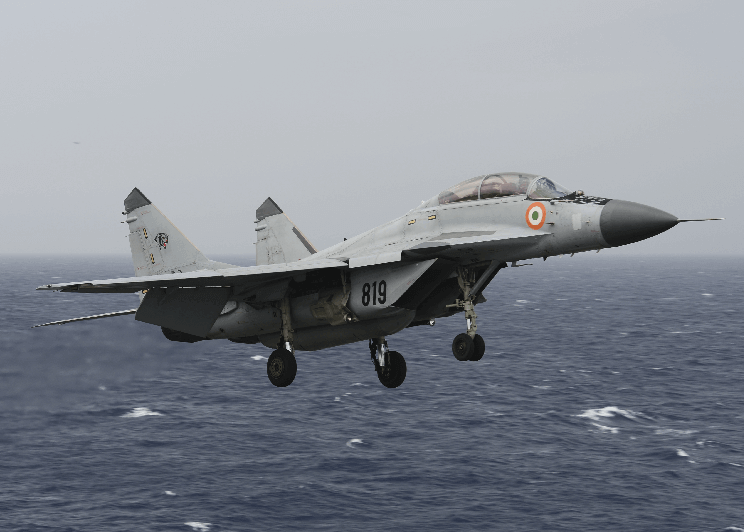The Indian Navy said on Friday that a MiG-29K trainer aircraft had crashed in the Arabian Sea around 5 pm on Thursday. One pilot was rescued while a search operation was launched for the second pilot who has been missing since the crash.
UAE Visa Ban Starts To Pinch Pakistan; 3000 Jobs Lost In First Week As Indian Workers Rejoice
“A MiG-29K trainer aircraft operating at sea ditched at about 1700 hrs on 26 Nov 20. One pilot has been recovered and search by air and surface units is in progress for the second pilot. An inquiry has been ordered to investigate the incident,” the Indian Navy said in a statement.
The crashed MiG-29K was not upgraded like the others in the fleet. The experts have pointed out the serviceability issue of the aircraft, but in 2018, then-Indian Navy Chief, Admiral Sunil Lanba, had said that all issues pertaining to the serviceability of MiG-29K were sorted out.
Serviceability implies that the aircraft is technically available and is not undergoing a scheduled repair or overhaul at any level
This is the third such crash involving the Navy’s Russian-made MiG-29k in a year. In November last year, a MiG-29K trainer aircraft had crashed outside Verna village in the South Goa district, followed by another in February, in which a bird hit was the primary cause of the accident in Goa. Both the pilots had ejected safely.
In May 2020, an Indian Air Force MiG-29 had crashed during a training mission in the Hoshiarpur district of Punjab.
#IAF fighter aircraft crashes in #Punjab. Sources say pilots safe. More details to come in. #Fighter #IAF pic.twitter.com/RTIUFm4O07
— ज़ाहिद अब्बास ZAHID ABBAS ?? (@abbaszahid24) May 8, 2020
According to a 2016 report by the Comptroller and Auditor General of India, the serviceability of the MiG-29K was unsatisfactory (37.63%) until 2015. However, with efforts made by the two countries, the serviceability has improved to around 70%, a Sputnik report said.
Experts say, only 1/3 of a fleet of 45 aircraft is operational at one time due to serviceability issues. In India, the MiG-29K is the choice of aircraft for both the aircraft carriers — INS Vikramaditya and an under-construction carrier.
The fighter jets are also deployed at two naval air stations, INS Dega at Visakhapatnam on the East Coast and INS Hansa at Goa on the West Coast, the mainstay of the Indian Navy’s air defense fleet.

Amid the border stand-off with China, the Defence Acquisition Council under the chairmanship of Defense Minister Rajnath Singh had in July accorded approval for the purchase of 21 MiG-29s along with the upgrade of 59 existing MiG-29 aircraft. India and Russia have been negotiating the purchase of MiG-29.
“Addressing the long-felt need of the Indian Air Force to increase its fighter squadrons, the DAC also approved the proposal for procurement of 21 MIG-29 along with up-gradation of existing 59 Mig-29 aircraft and procurement of 12 Su-30 MKI aircraft. While the MIG 29 procurement and up-gradation from Russia is estimated to cost Rs 7418 crore [$991 million], the Su-30 MKI will be procured from HAL [Hindustan Aeronautics Limited] at an estimated cost of Rs 10730 crore [$1.43 billion]”, the Defense Ministry had said in a statement.
But the crashes raise serious questions over the acquisition of these fighter jets for $991 million. Experts speculate that India may not buy more MiG-29k or even MiG-35 for the IAF. They say the better options for India are Rafale fighter jets or F-18.
The MiG-29 is considered one of the world’s most prolific fighter jets due to its usage in both NATO and CIS Air Forces, but over 50-year-old aircraft is no match for the French Rafale or other Western counterparts.
First inducted in the 1980s, the aircraft was conceived as a low-end, air-superiority fighter. One more area where it falls out is that it has a lesser powerful radar as compared to the Rafale, which boasts a multi-directional radar system that can detect 40 targets at the same time in a range of over 100 kilometers.
However, Turkish radars were unable to detect the approaching MiG-29 fighters in Sirte and the fighter jets destroyed Turkish air defense systems. Considering these developments, there is a huge question if India should move towards advanced western jets or continue with Russian technology.




